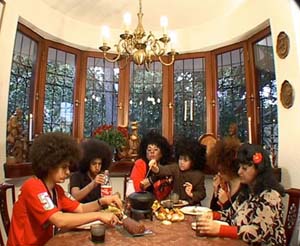[…] In Gullet, Heiman focuses on the gap between the ideal and the concrete, the virtual and the real, the personal and the anonymous. The individual virtual identity of the chat rooms [from her previous work], however, is replaced by the fictive family, a family that is, in fact, a ‘mixture’ of acquaintances, authentic family members, and total strangers. The radical treatment, the props, the stylized design, the humor, the exaggeration, and the grotesque lend each of the meals an air of familiarity and estrangement at the same time. On the one hand, there is the mundane banal ritual of a family meal; on the other, the setting looks like a maquette, like theatrical decor. The domestic environment reflects design styles popular among the Israeli bourgeoisie (plastic flowers and animal figurines on the windowsill). The ritual becomes mechanical; family members resemble a monstrous food processor. The reverse screening creates a discharge effect, as if the food is returned from the mouth to the plates that gradually pile in the course of the meal. The body language is distorted, and the reverse sound transforms the rustle of knives and forks into a hiccup-filled fencing match.
Heiman subverts the fantasy of the family’s sanctity. A potentially intimate graceful moment of familial togetherness becomes a hollow choreography that speaks of loneliness and detachment. The meal remains functional (“In the museum they will eat continuously for eight hours a day”). Apart from passing the salt and pepper, there is no communication whatsoever between family members. Each keeps to his/her own plate. Every bite they take into their mouths gnaws upon the utopian harmony of the family unit; the idyll is violated, and as the minutes pass, the meal is increasingly perceived as an empty ritual of collective stuffing. […]
Excerpts from Tami Katz-Freiman’s essay “Family Dyes” in Meirav Heiman’s exhibition catalogue
Less Reading...
